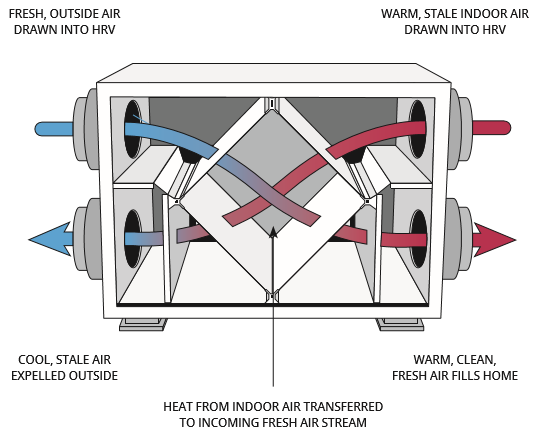Breaking Down HRV: A Step-by-Step Introduction
Wiki Article
The All-Inclusive Guide to the Uses of Heat Recovery Ventilation in Modern Buildings
Heat Recovery Ventilation (HRV) systems represent a substantial development in constructing modern technology (HRV Heat Recovery Ventilation). They give a technique for exchanging stale indoor air with fresh outdoor air while lessening energy loss. This strategy not only boosts indoor air top quality but additionally adds to energy performance in both domestic and business buildings. Recognizing the different applications and advantages of HRV can reveal its essential function in modern-day design and sustainability efforts. The effects of this technology deserve discovering even moreRecognizing Heat Recovery Ventilation Systems

Many contemporary structures focus on power performance, understanding heat recuperation air flow (HRV) systems is essential for enhancing indoor air high quality and lowering power intake. HRV systems function by transferring heat from stale indoor air to incoming fresh air, successfully preserving comfy interior temperatures while decreasing energy loss. These systems include a warm exchanger, followers, and ductwork that assist in the blood circulation of air. Throughout winter, HRV units capture and reuse heat from the outgoing air, while in summertime, they can assist cool incoming air. By constantly exchanging air, HRV systems likewise decrease humidity and the concentration of indoor contaminants. Correct installation and upkeep of HRV systems are necessary for their performance and performance in boosting total structure performance and comfort.
Benefits of Heat Recovery Ventilation
Heat recovery ventilation systems provide many benefits that boost both power effectiveness and indoor air high quality in modern buildings. By recording and recycling energy from exhaust air, these systems considerably reduce heating & cooling prices, bring about lower energy usage. They maintain a consistent flow of fresh outdoor air, reducing the danger of interior air toxins and allergens. This continuous exchange aids regulate moisture levels, preventing mold growth and ensuring a much healthier living environment. Furthermore, HRV systems contribute to sustainability goals by lowering general carbon impacts. Their capability to optimize air flow without compromising thermal convenience makes them a useful addition to modern building style, advertising both economic and environmental advantages.Applications of HRV in Residential Buildings
As homeowners increasingly prioritize power efficiency and indoor air top quality, the applications of heat healing air flow (HRV) systems in residential buildings have actually come to be much more common. HRV systems are specifically advantageous in securely secured homes, where maintaining fresh air circulation is necessary for preventing moisture accumulation and interior toxins. They effectively move warmth from outgoing stale air to incoming fresh air, decreasing energy expenses connected with heating & cooling. Additionally, HRVs can boost convenience degrees by managing humidity and temperature. They are also adaptable for various household designs, including single-family homes and multi-unit buildings. On the whole, integrating HRV systems sustains lasting living techniques while making certain a much healthier interior setting for occupants.HRV in Business and Commercial Settings
In industrial and industrial settings, the implementation of warmth recuperation air flow (HRV) systems has ended up being progressively critical for enhancing energy effectiveness and maintaining air high quality. These systems successfully transfer warm from exhaust air to inbound fresh air, minimizing the Find Out More requirement for added heating or air conditioning. This not just decreases power expenses however also contributes to sustainability efforts. Industries such as manufacturing, warehousing, and office structures profit substantially from HRV systems, as they aid control temperature and humidity degrees, making certain a comfy and efficient environment. HRV systems help in removing contaminants and excess wetness, improving indoor air quality. As policies around air high quality end up being stricter, pop over here the fostering of HRV modern technology is most likely to grow, making it a vital element of contemporary business and industrial infrastructure.Future Trends in Heat Recovery Ventilation Innovation

Frequently Asked Concerns
Exactly How Does Heat Recovery Ventilation Impact Indoor Air Top Quality?
Heat recovery ventilation substantially improves indoor air high quality by constantly exchanging stale interior air with fresh outdoor air while recuperating energy. This procedure lowers toxins, preserves perfect humidity degrees, and assures a much healthier atmosphere for residents.Can HRV Solutions Be Installed in Existing Structures?
HRV systems can without a doubt be set up in existing structures. Retrofitting may require alterations to ductwork and air flow layouts, but it substantially improves energy effectiveness and indoor air top quality, making it a sensible alternative for older frameworks.What Maintenance Is Required for HRV Systems?

Exist Certain Climates Where HRV Is Much More Effective?
Heat recovery ventilation systems are specifically efficient in climates with substantial temperature level distinctions between seasons. These systems optimize power performance by recovering warm from exhaust air, making them optimal for both cool and reasonably cozy environments.Exactly How Do HRV Systems Affect Energy Bills?

Report this wiki page